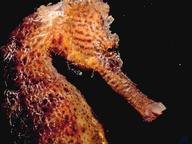Quiz Answer Key and Fun Facts
1. The name "seahorse" comes from the fact that they live in the sea and look like they have the head of a horse. Seahorses are members of the genus Hippocampus, which is a combination of Greek words meaning what?
2. Seahorses are members of the genus Hippocampus. Even if you do not own a seahorse, you do have a hippocampus. Where is it?
3. Seahorses have a tail that curls forward - what do they use their tail for?
4. Are seahorses strong swimmers?
5. Seahorses share many of the same characteristic features of a chameleon. Which of the following do a seahorse and chameleon not have in common?
6. Seahorses are an unusual fish, but they are a fish. Which of the following body parts do seahorses possess?
7. In seahorses (and other members of the family Syngnathinae, such as pipefish), the male seems to become pregnant. Does this happen in any other fish?
8. Are all seahorses monogamous (one female and one male mate exclusively)?
9. Do any seahorses live in freshwater?
10. What is the biggest threat to seahorses?
Source: Author
jcpetersen
This quiz was reviewed by FunTrivia editor
crisw before going online.
Any errors found in FunTrivia content are routinely corrected through our feedback system.

